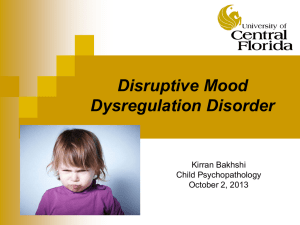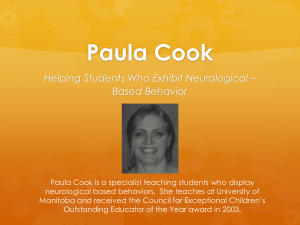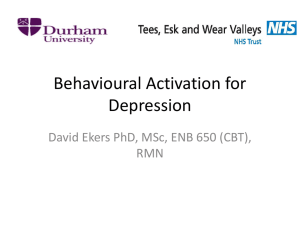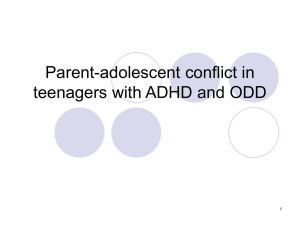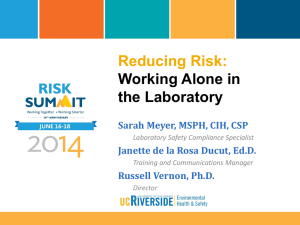Chelsea-DMDD-Presentation-2014
advertisement
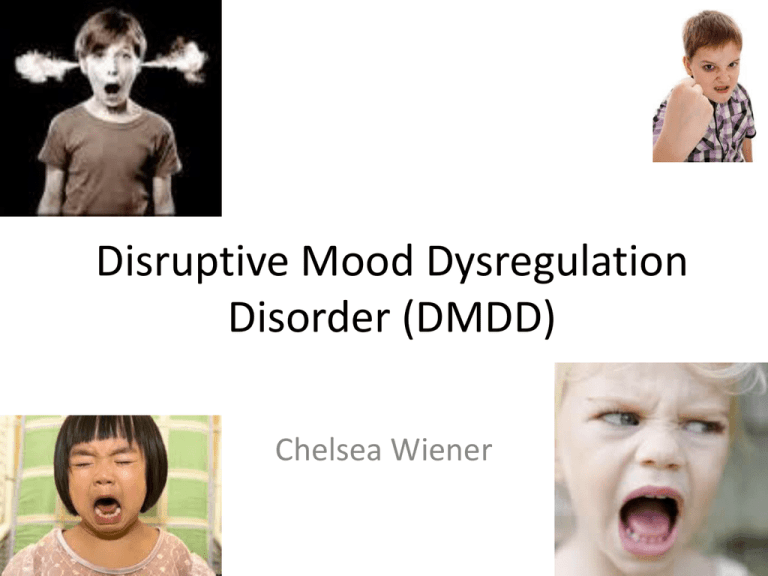
Disruptive Mood Dysregulation Disorder (DMDD) Chelsea Wiener Part 1 DMDD and the DSM V DMDD Diagnostic Criteria: DSM V A. Severe recurrent temper outbursts (verbal or behavioral aggression) “grossly out of proportion in intensity or duration” B. Temper outbursts inconsistent with development level C. Outbursts occur average of 3+ times/week D. Mood in-between outbursts is irritably or angry most of the day, nearly every day E. A-D present 12+ months. No 3+ month period without all of the symptoms F. A+D present in at least 2/3 settings (home, school, peers) and severe in at least one setting DMDD Diagnostic Criteria: DSM V G. Diagnosis not made before age 6 or after age 18 H. Age of onset for A-E before 10 years old -No time period lasting more than a day when full symptom criteria met for manic or hypomanic episode J. Symptoms not solely during major depressive disorder, and not better explained by another mental disorder -diagnosis cannot coexist with ODD K. Symptoms cannot be attributed to substance use or another medical or neurological condition DMDD Diagnostic Features: DSM V • Core feature: “chronic, severe persistent irritability” – Temper outbursts – Irritable angry mood in-between outbursts • vs. pediatric bipolar: distinct manic episodes DMDD Prevalence: DSM V • Unclear estimates for full DMDD criteria • Estimates for chronic and severe irritability: – 6 mo.- 1 year period= 2-5% • Higher in males and school age children – (vs. bipolar: gender balance more equal) DMDD Development & Course: DSM V • Onset of symptoms before 10 years old (cannot be diagnosed before 6 years old) • ~1/2 children presenting with severe chronic irritability meet criteria for DMDD 1 year later • Later Risks: – Depression and anxiety in adulthood – Less evidence for development of bipolar disorder later in life • DMVDD vs. Bipolar – Bipolar rates low prior to adolescence (less than 1 percent); DMDD more common prior to adolescence and become less common over time Risk and Prognostic Features: DSM V • Temperamental – Irritability prior to diagnosis – May also have symptoms for ADHD, anxiety, depression • Genetic + Physiological – Risks for both DMDD (chronic irritability) and bipolar: • Similar familial rates of anxiety, depression, and substance use • Similar face-emotion labeling deficits • Compromised decision making and cognitive control – Risks for DMDD (chronic irritability) alone: • Dysfunction in attention related to emotional stimuli Consequences of DMDD- DSM V • Chronic severe irritability associated with: – Problematic relationships • Family, classmates, friendships – Trouble in school – Dangerous actions, suicide attempts, aggression, psychiatric hospitalization • Common with pediatric bipolar as well Differential Diagnosis for DMDD *Bipolar -episodic -manic episodes include cognitive, behavioral and physical symptoms, and sometimes elevated mood and grandiosity -cannot be dually diagnosed; cannot be diagnosed with DMDD if ever manic for a day *ODD -DMDD children often have ODD symptoms, but less so vice versa -15% children who meet ODD criteria meet DMDD criteria -only DMDD diagnosis is made -DMDD has recurrent severe outbursts -DMDD has “severe impairment” in at least one setting, and impairment in a second setting Differential Diagnosis for DMDD ADHD (can be dually diagnosed) Depression (can be dually diagnosed) -if irritability only during depressive episodes, then DMDD diagnosis not made Anxiety disorders (can be dually diagnosed) -if irritability only when experiencing anxiety, then DMDD diagnosis not made Intermittent explosive disorder -DMDD includes irritability in-between outbursts -IED needs 3 mos. active symptoms for diagnosis vs. 12 mos. For DMDD Autism spectrum -if outbursts are only in relation to disturbed routines as part of autism spectrum, no DMDD diagnosis made Comorbidity • Highly comorbid • Strongest overlap with ODD – Only DMDD diagnosis made • Comorbid with mood, anxiety, autism spectrum syndromes and symptoms DSM V Schematic Chronic irritability Risk For: Temperament Symptoms for: ODD, ADHD, anxiety, MDD DMDD Familial anxiety, depression, substance use Secondary Features: Genetic/Physio logical Face emotion labeling differences Depression, anxiety, suicidality, severe aggression, dangerous behavior, psychiatric hospitalization Attention/cogni tion differences Primary Features: severe, chronic irritability temper tantrums Problematic relations with others (peers, family), poor performance in school, low frustration tolerance, dangerous behaviors, suicidality Part 2: Development and Prevalence of DMDD • Development of DMDD – Development of Severe Mood Dysregulation Disorder (SMD) • DMDD Predictors, Prevalence, Comorbidity • SMD Prevalence, Comorbidity, Course Part 2: Development and Prevalence of DMDD • Development of DMDD – Development of Severe Mood Dysregulation Disorder (SMD) • DMDD Predictors, Prevalence, Comorbidity • SMD Prevalence, Comorbidity, Course Development of DMDD: pediatric bipolar disorder and Severe Mood Dysregulation Disorder • Large increases since 1990’s of new pediatric BP cases (Zepf & Holtmann, 2012) – Children being diagnosed without characteristic episodes (at least 1 week mania, 4 days hypomania) – Can be lead to problems of lifelong medication (Marguiles et al., 2012) development of Severe Mood Dysregulation (SMD) proposed by Leibenluft et al. (2003) • Probability of SMD children developing manic or hypomanic episode 50x lower than pediatric BP children (Stringaris et al., 2010) • SMD children found to have higher ADHD and ODD comorbidity rates (82.1%, 78.6% respectively) than BP children (45.2%, 25.8%) (Stringaris et al., 2010) Development of DMDD: Severe Mood Dysregulation Disorder Leibenluft et al. (2003) A. Age 7-17 yrs. old – Onset before 12 yrs. B. Abnormal mood (anger or sadness) at least half the day on most days – noticeable to others C. Hyperarousal – at least 3: insomnia, agitation, distractibility, racing thoughts, pressured speech, intrusiveness D. Increased reactivity to negative emotional stimuli – E.g. temper tantrums, verbal rages, aggression to people or property • Average 3+x/week for past 4 weeks E. F. B-D present for a least 12 months (including current) and no 2 month remission Severe symptoms in at least one setting (school, home, peers), and at least mild symptoms in another setting SMD Diagnosis: Exclusions A. Elevated mood, grandiosity/inflated self-esteem, decreased need for sleep (episodic) B. Symptoms occur in distinct periods (>4 days) C. Schizophrenia, schizophreniform disorder, schizoaffective illness, pervasive developmental disorder, PTSD, substance abuse in past 3 months D. IQ<80 E. Symptoms result of drug, abuse, medical or neurological condition Concerns regarding development of DMDD • More juvenile diseases may lead to more pediatric medication • Lack empirical support for DMDD in particular (support for SMD) • Not 100% overlap between SMD and DMDD – Hyperarousal component of SMDD – Different age onsets – One study found 47.4% DMDD children met SMD criteria; 58.1% SMD met DMDD (Dougherty et al., 2014) Part 2: Development and Prevalence of DMDD • Development of DMDD – Development of Severe Mood Dysregulation Disorder (SMD) • DMDD Predictors, Prevalence, Comorbidity • SMD Prevalence, Comorbidity, Course DMDD Prevalence and Comorbidity Copeland et al. (2013) – Looked at 3 previous large scale studies and calculated rates of DMDD using symptoms endorsed via psychiatric interview – Ages 2-17* • Prevalence – 3 month rate: .8-3.3% • .8-2.9% if use exclusion criteria with other disorders • More common in pre-schoolers* – Temper tantrums (especially in pre-schoolers) and negative mood were most common symptoms endorsed – Age onset X<10: no difference on prevalence rate when older DMDD Prevalence and Comorbidity • Comorbidity – Most comorbidity with depressive disorders and ODD • Depressive disorders – Odds ratio: 9.9-23.5 » Among those with depression, 11.8-23% had DMDD • w/o depression: .8-2.9% had DMDD » Among those with DMDD, 12.4-35.8% had depression • w/o DMDD: 1.4-3.2% had depression • ODD – Odds ratio: 52.9-103.0 » Among those with ODD, 23-37.7% had DMDD • w/o ODD: .4-1% had DMDD » Among those with DMDD, 57.4%-70.6% had ODD • w/o DMDD: 2.2-3.8% had ODD – DMDD diagnosed alone 8%(preschoolers)-38% of the time DMDD Correlates and Predictors Dougherty et al. (2014) – Interviewed children at 3 yrs. old then 6 yrs. old • Prevalence: 8.2% (full criteria) – Didn’t take into account exclusions for other disorders (e.g. mania, IED) • • • • • 13.2% comorbid depressive disorder 13.2% comorbid anxiety disorder 10.5% ADHD 55.3% ODD 39.5% DMDD only DMDD Correlates and Predictors • DMDD predictors: – ODD – ADHD – Maternal CBCL-DP classification • Focus on attention problems, anxious/depressed feelings, aggressive behavior – Lower peer functioning • Rated by teacher – Higher surgency (rated by mom) • “high-intensity pleasure, impulsivity, activity, low shyness” • Child behavior questionnaire – Lower effortful control (rated by mom and dad) • “inhibitory control, attention focusing, low-intensity pleasure” – Higher child negative emotional intensity (rated by teacher) – Parental lifetime substance use disorder – Greater parental hostility • Observed in lab DMDD Stability and Comorbidities • Axelson et al. (2012) – 706 children (6-12 yrs.) from Longitudinal Assessment of Manic Symptoms Study – Retrospective DMDD diagnosis • Didn’t exclude ODD+bipolar – Intake: • DMDD present in 26% of participants, more common in those with elevated manic symptoms • DMDD+ vs. DMDD– Higher DBD rates, dysthymia, elimination disorders, ADHD (not bipolar) for DMDD+ – Multivariate model: ODD Odds Ratio: 68.7; CD Odds Ratio: 77.8 – didn’t differ on biological parent depression, bipolar, anxiety, psychosis, substance use disorder, or CD DMDD Stability and Comorbidities – 1 Year Follow Up DMD Stability: • 53% of those who met DMDD at intake did so a year later • 64% of those who met DMDD at 1 yr. follow up had DMDD at intake – 2 Year Follow Up DMDD Stability: • Of those who met DMDD criteria at least 1 time, 19% met all 3 times – vs. of those with ADHD at least 1 time, 61% had all 3 times *questions of stability DMDD Stability and Comorbidities • DMDD at intake not associated with increased risk for later bipolar, anxiety, psychosis, CD, depressive disorders • 71% with ODD/CD had DMDD (3% without ODD/CD had DMDD) – Intake: • • • • • 58% of ODD children had DMDD 61% of CD children had DMDD 96% DMDD children had ODD or CD 96% DMDD met ODD or CD vs. 40% BP had comorbid ODD or CD 77% DMDD+ met ADHD and ODD/CD • 44% of those with ADHD had DMD, 23% without ADHD had DMDD • No differences for MDD, Bipolar, Anxiety *questions of comorbidity with ODD and CD *population considerations DMDD Stability and Comorbidities Part 2: Development and Prevalence of DMDD • Development of DMDD – Development of Severe Mood Dysregulation Disorder (SMD) • DMDD Predictors, Prevalence, Comorbidity • SMD Prevalence, Comorbidity, Course Prevalence, Co-occurence and Course of SMD Brotman et al. (2006) • Used participants from Great Smoky Mountains Study (community sample) • Looked at modified SMD – Chronically irritable, angry, depressed – Excessive reactivity 3+/week – Hyperarousal • Insomnia, pressured speech, distractibility, physical restlessness, racing thoughts, intrusiveness Prevalence, Co-occurence and Course of SMD • Lifetime prevalence 3.3% for 9-19 yrs. old • Co-occurrence at time first met SMD criteria: – 67.7% had co-occurrence of another disorder • • • • • 26.9% ADHD 25.9% CD 24.5% ODD 14.7% anxiety 13.4% depression Prevalence, Co-occurence and Course of SMD • SMD at Wave 1 (mean age~10.6) predicted depressive disorders at last wave (mean age~18.3) – Odds Ratio: 7.2 – Depressive disorders at Wave 1 didn’t predict depressive disorders at last wave – Not predictive of ADHD, CD, ODD, substance abuse, anxiety Development and Prevalence of DMDD: Review • DMDD Development: – Increased in diagnosis of pediatric BP without distinct manic episodes SMD (includes hyperarousal component) DMDD • DMDD Prevalence ~ 1-8% – Common comorbid conditions: ADHD, depression, ODD • ADHD comorbidity estimates may vary widely based on sample used – Diagnostic stability unclear • DMDD Predictors – ODD, ADHD, temperament, parent factors • SMD prevalence ~3% • SMD predictive of later depressive episodes Part 3: DMDD Research • Emotional Labeling/Emotional Differences • Neural Differences • Treatment Part 3: DMDD Research • Emotional Labeling/Emotional Differences • Neural Differences • Treatment Face Emotion Labeling Deficits- SMD vs .BD Rich et al. (2008) • Participants: NP BD (have had manic or hypomanic episode), SMD, NC • Emotional expression multimorph task (morph task) – Gradations of facial emotions • 100% neutral to 100% expressive – Happiness, surprise, fear, sadness, anger, disgust – Participants can “stop” at any point and provide answer (correct identification), then continue and change answer Face Emotion Labeling Deficits- SMD vs. BD • Morph task results: – BD and SMD children needed more morphs before first responding (regardless of correct response), and responding correctly • Social functioning and morph task results: • SMD: worse family function (measured by LIFE scale) related to worse recognition r = -.71 • BD: poorer social reciprocity (measured by SRS) with poor recognition r = -.48 Face Emotion Labeling Deficits- SMD vs. BD Guyer et al. (2007) • Compared the following groups (7-18 yrs. old) on a facial emotion labeling task: – BD, SMD, ANX/MDD, ADHD/CD, control • ANX/MDD: Generalized anxiety, social phobia, separation anxiety, or major depression • High and low intensity expressions of happiness, sadness, anger, fear. • Results: SMD and BD made more errors than other groups (but did not differ from each other) Attentional Differences to Emotional Stimuli- SMD vs. BD Rich et al. (2010) • Assessed SMD, BD, and NC (~10-15 yrs. old) on “impact of emotional stimuli on attention” • Emotional Interrupt Task: – Fixation point emotional picture (negative, positive, neutral) target (circle or square) picture blank screen • Press left button if circle, right if square – reaction time Attentional Differences to Emotional Stimuli- SMD vs. BD Attentional Differences to Emotional Stimuli- SMD and BD • Results: – Between-groups response time differences • BD slower to respond than NC after seeing all pictures • SMD slower to respond than NC after neutral pictures – Within-groups response time differences • NC and BD significantly slower to respond after negative and positive pictures vs. neutral pictures • ***SMD did not vary based on emotion – BD and SMD lower accuracy than NC Attentional Differences to Emotional Stimuli- SMD and BD • Attention interference scores: subtract neutral RT from neg./pos. RT – SMD lower RT interference (regardless of comorbidities) than BD and control for both positive and negative pictures • SMD RT interference for negative pictures related to impaired peer relationships (r=0.35), and impaired social reciprocity (r=-0.47) Emotional Labeling/Emotional Differences: A Review • SMD children more time to correctly facial expressions • Make more errors in identifying correct facial expressions • Emotional stimuli have less effect on attention Part 3: DMDD Research • Emotional Labeling/Emotional Differences • Neural Differences • Treatment Amygdala Activation and Emotional Processing Brotman et al. (2010) • Compared children with SMD, BP, ADHD, and NC on amygdala activation during emotional processing of neutral faces using fMRI • 8-17 yrs. old • Emotional face paradigm: – Happy, angry, fearful, and neutral faces – Passive viewing of face, rate how hostile (perceived threat), subjective fear (how afraid), and nose width Amygdala Activation and Emotional Processing • Results: – BP and SMD more rated more fear for neutral faces than NC – Activation differences in left amygdala during fear+nose-width rating contrast: • ADHD hyperactivation vs. NC, BP, and SMD • SMD hypoactivation vs. NC, BP, ADHD – No differences in left amygdala activation during hostility and nose-width rating contrast – Activation differences in left amygdala during nose width vs. fixation trials • SMD hyperactive vs. BP, ADHD, NC • NC hypoactivation vs. BP And ADHD *even though SMD rated faces are more fearful, showed under activation of amygdala Neural Responsiveness to changes in facial expression Thomas et al. (2012) • 8-18 yrs. old BD, SMD, NC • Pictures went from neutral to 100% angry, and neutral to 100% happy – 25% increments – Nose width and hostility ratings Neural Responsiveness to changes in facial expression • Amygdala activation analysis – NeutralAngry • Left amygdala differences – NC had an increase in amygdala activation as anger increased, BD and SMD did not – NeutralHappy • No differences *again, amygdala underactivation for SMD Neural Responsiveness to changes in facial expression • Whole brain analysis – Neutral Angry • Left posterior cingulate (LPC): NC more activation with increased anger – Authors suggest more effortful processing – LPC activated by emotional stimuli and connected to amygdala and other regions Neural Responsiveness to changes in facial expression • Whole brain analysis – Neutral Happy • Main effect of group on right inferior parietal lobule (brodmann area), left middle occipital gyrus and fusiform gyrus, right middle occipital gyrus and cuneus, and left middle/superior frontal gyrus. – BD had more negative slope than SMD and NC (except left middle occipital gyrus) » BD children: increase expressions of happiness associated with decrease in activation – SMD had a more positive slope than NC for all » SMD children: increase in expressions of happiness associated with increase in activation *these brain these brain regions associated with emotional processing, face processing, and attention Neural Responses to Frustration Deveney et al. (2013) • 8-17 yrs. old. • SMD (met criteria for DMDD) vs. NC on Posner spatial cue task – Includes monetary rewards, and frustration • Two squares cue in one square target – Respond to target location, cue predicted 75% of time • Frustration portion: – For one section of task, computer gave feedback that response was “too slow” 60% of time regardless of speed Neural Responses to Frustration Neural Responses to Frustration • Results: – SMD children reported more frustration at end of frustration task vs. NC – During frustration task SMD responded more slowly than NC on invalid trials – Amygdala analysis: • SMD less activation in left amygdala on negative feedback trials • SMD within group differences: less activation in left amygdala on negative vs. positive feedback trials (no difference for NC) – Striatum analysis: • SMD less activation in left and right striatum during negative feedback trials • SMD less activation during negative vs. positive feedback trials (not seen in NC) – Whole brain analysis: • SMD less activation during negative feedback in parietal, parahippocampal, and thalamic/cingulate/striatal regions • SMD less activation in these regions during neg. vs. pos. feedback (not seen in NC) Neural Responses to Frustration • Implications – slower RT time during frustration task may be related to difficulty shifting spatial attention from cue (involvement of parietal hypoactivation) *Attention allocation skills important for emotional regulation – possibility of decreased striatal response during negative feedback being related to reward processing • Outcome worse than expected experience as more frustrating because unexpected and averse links to exaggerated responses to frustrating events Neural Responses: SMD vs. BP Rich et al. (2011) • Neural response differences: SMD vs. BD vs. NC on Affective Posner task • Results: – SMD reported feeling more aroused (agitated) than BD and control during negative feedback – SMD and BP reported more unhappiness throughout task Neural Responses: SMD vs. BP Neural Responses: SMD vs. BP Neural Responses: SMD vs. BP – Left anterior cingulate cortex (ACC): • Negative feedback: SMD > control • Positive feedback: Control > SMD – Medial frontal gyrus (MFG): • Negative feedback: SMD > control • Positive feedback: Control > SMD – Superior frontal gyrus (SFG): • Negative feedback: BD > SMD and control • Positive feedback: no differences – Insula: • Negative feedback: SMD and control > BD • Positive: BD > SMD – Supplementary motor area (SMA): • Negative feedback: control > SMD • Positive feedback: BD> SMD and control Neural Responses: SMD vs. BP • Implications: – ACC, PFC, Insula: related to frustration – ACC and MFG: related to evaluating, resolving, and monitoring emotional conflict – SFG: related to executive attention – BA 6 (in SMA): cognitive activity – Insula: processing negative and positive affect *greater arousal in negative situations Neuropsychological test performance: SMD vs. ADHD Uran & Kılıç (2014) • Participants: – 7-18 yrs. old. referred to University clinic – Compared SMD vs. ADHD vs. NC on neuropsychological test – Neuropsychological tests: • Wisconsin card sorting task (WCST) – Evaluates planning, searching, shifting cognitive sets, cognitive flexibility • Stroop task – Selective attention and response inhibition • Trail making task – Visual attention and task switching • Controlled oral word association test – Verbal fluency and reasoning • Controlled oral word association test – Verbal fluency and reasoning • Category naming test (CNT) – Producing words, attention, set shifting Neuropsychological test performance: SMD vs. ADHD – Performance on neuropsychological tests was comparable between ADHD and SMD participants • ADHD < control on measures of WCST, TMT, Stroop, COWAT • SMD < control on COWAT – Further comparisons of SMD vs. ADHD • Parents and teachers rated SMD higher in hyperactivity, social problems, impulsivity, emotional reliability Neural Differences: A Review • SMD hypoactivation of amygdala with fear-inducing faces and angry faces • Different brain activation patterns when viewing expressions of happiness in areas of brain related to emotional processing and attention • Different brain activation patterns during negative feedback in areas of the brain related to emotional conflict, executive attention, cognition, processing affect • Greater reports of frustration, negative feelings, and arousal during frustration/attention tasks • Greater difficulty in attention deployment • SMD children perform comparably to NC children on multiple neuropsychological tests Part 3: DMDD Research • Emotional Labeling/Emotional Differences • Neural Differences • Treatment Treatment for SMD: Lithium? Dickstein et al. (2009) • Why Lithium? – Irritability and aggression • Participants: 7-17 yrs. • Weaned off medication for 4 half lives , 2 weeks of placebo/hospitalization evaluated for SMD, if criteria still met randomized to lithium or placebo for 6 weeks Treatment for SMD: Lithium? • Results: – After placebo period: 25 randomized, 20 no longer met criteria for SMD – Clinical Global Impressions Scale • No between groups differences regarding CGI < 4 (improved, much improved, or symptom free) – 3/14 lithium and 1/11 placebo – Positive and Negative Syndrome Scale Factor 4 – Measures excitement, hostility, uncooperativeness, poor impulse control • No between group differences – Little evidence for metabolite differences Treatment for SMD: Lithium? Treatment for SMD: Risperidone? Krieger et al. (2011) • 21 participants – 19 completed full 8 week study – Baseline, 2 week, 4 week, 6 week, 8 week evaluations – Mean: 10 yrs. old – Comorbidities: • 71.4% ADHD, 66.7% anxiety disorders, 81% ODD Treatment for SMD: Risperidone? • Results: – ABC Irritability (Irritability Scale of the Aberrant Behavior Checklist) • Baseline average: 25.89 (18+ is considered “severe impairing irritability”) • Significantly reduced over time – – – – Week 2 mean: 12.03 (ES 1.39) Week 4 mean: 15.48 (ES 1.51) Week 6 mean: 12.29 (ES 1.77) Week 8 mean: 11.28 (ES 1.83) Treatment for SMD: Risperidone? – Clinical Global Assessment Scale • Significant reductions from baseline (mean = 4.53) – – – – Week 2 mean: 2.85 Week 4 mean: 2.96 Week 6 mean: 2.69 Week 8 mean: 2.64 – Children’s Depression Rating Scale • Significant reductions from baseline (mean=34.28) – – – – Week 2 mean: 24.11 Week 4 mean: 26.40 Week 6 mean: 25.93 Week 8 mean: 22.50 Treatment for SMD+ADHD patients: Methylphenidate and Behavior Modification Waxmonsky et al. (2008) • 101 Participants from a Summer Treatment Program for ADHD – Ages 5-12 – 2 hours academics a day, 7 hours recreation – Some campers with SMD • Behavior modification (BMOD) and medication (methylphenidate/MPH) component – High, low, and no BMOD • Every 3 weeks, switch BMOD condition – Placebo, .15 mg, .3 mg, .6 mg MPH condition • Changed each day • SMD group had Young Mania Rating Scale (YMRS) score of more than 12 (to test concerns about stimulant use) • Parents had skills training course at home Treatment for SMD+ADHD patients: Methylphenidate and Behavior Modification – BMOD Levels • High: social skills training, reward/cost point system, time-outs, report cards detailing behavior, individualized behavior plans etc. • Low: weekly contingency rewards (vs. daily in HBM), behavior plans not individualized • None: no contingent rewards Treatment for SMD+ADHD patients: Methylphenidate and Behavior Modification Treatment Conditions: Treatment for SMD+ADHD patients: Methylphenidate and Behavior Modification • Results: – SMD group elevated ODD and CD ratings throughout camp – Significant reduction in ADHD, ODD, and CD symptoms over time for all groups (but no group X time interaction) – ADHD ratings: • 85% of SMD showed at least a 50% improvement in time following activity rules (FAR), seatwork completed (SC), and non compliance to staff requests (NC) – For over half of SMD participants, it was low or medium medication with an active BMOD condition • FAR – All MPH and BMD doses affected SMD and non SMD children comparably with regards to FAR, percentage of seatwork completed, and non compliance to staff requests » Exception: .3 mg low intensity BMOD Treatment for SMD+ADHD patients: Methylphenidate and Behavior Modification – Percent of Rules followed by dosage: » Placebo • Non SMD vs. SMD: 34.59/32.48% » .15 mg • Non SMD vs. SMD: 48.05/43.99% » .3 mg • Non SMD vs. SMD: 56.6/53.62% » .6 mg • Non SMD vs. SMD: 67.16/63.14 – Percent of Rules followed by behavior modification therapy condition: » none: • Non SMD vs. SMD: 34.59/32.48% » low: • Non SMD vs. SMD: 49/45.23% » high: • Non SMD vs. SMD: 54.4./51.79% Treatment for SMD+ADHD patients: Methylphenidate and Behavior Modification • Medication side effects: – No exacerbation of manic symptoms – Side effects more frequent at .6 mg dose (11 ppl had to reduce2 SMD and 9 non SMD) – SMD subjects: increase in trouble sleeping and being withdrawn, but irritability ratings decreased • YMRS Scores • 8.3 (34%) point total improvement in SMD subjects – – – – ODD cluster (47% of difference) ADHD cluster (23% of difference) Mania cluster (25% of difference) Decline of 11 points (31%) in children depression rating scale revised • Children Depression Rating Scale Revised: 34% improvement Treatment for SMD and ADHD: Group Therapy Waxmonsky et al. (2013) • Participants: – 7-12 years old boys – ADHD and SMD (all taking medication) • 9 week pilot trial, 7 families • Therapy program: treatment of ADHD and impaired mood (AIM) – 9 week parent and child intervention (separate interventions) ( 6 week follow up) – At academic research center – Used materials from 4 other interventions Treatment for SMD and ADHD: Group Therapy – Parent sessions • Behavior modification principles • Improve relations, consistency, communication, praise positive actions, appropriate time outs and contingencies, recognize triggers etc. – Child sessions • Contingency management, problem solving skills, emotion identification, cognitive “toolbox” Treatment for SMD and ADHD: Group Therapy – Results: • Children’s Depression Rating Scale- Revised – Pre, post, and follow up means: 30.43, 23.57, 24.69 » Pre-Post treatment d = 1.17 » Pre-Follow up d = 1.26 – “clinically meaningful change”: decrease of 40% from baseline score » 4 had shown baseline “clinically significant impairment” • 2/4 showed clinically meaningful change at post, but not retained at follow up • Young Mania Rating Scale – Pre, post, and follow up means: 14.71, 10.43, 9.71 » Pre-Post treatment d = 0.81 » Pre-Follow up d = 1.43 – “clinically meaningful change”: decrease of at least 25% from baseline score » 6 had shown baseline “clinically significant impairment” • 4/6 showed clinically meaningful change Treatment for SMD and ADHD: Group Therapy – Behavior ratings • Small effects of parent ratings of ADHD, ODD, and CD, not maintained at follow up – Impairment ratings • Improvement of CGAS scores baseline to post (d = 2.17) – Baseline mean: 47.86= “serious level of symptoms” – Post mean: 66.43 = “mild to moderate symptom severity” – Follow up mean: 53.57 – Parent behavior • Greatest gains seen for reductions in corporal punishment pre-follow up (d = 0.93) – Baseline mean: 4.71 – Follow up mean: 3.50 Treatment: A Review • Lithium not shown to be effective in treating SMD • Risperidone shown to be effective – Reduces irritability ratings • Combination of Methylphenidate and Behavior Modification effective in increasing rule-following and decreasing externalizing problems for comorbid SMD/ADHD children • Parent and child interventions shown to reduce depression and mania symptoms in ADHD/SMD children DMDD Research Schematic medication Labeling deficits, different neural responses Differences in: *amygdala activation ACC, MFG, SFG, Insula, Striatal Agitation, irritability, low frustration tolerance Hostility, lifetime substance use Emotion Processing Differences Genetic/Physiol ogical Temperament Parent Factors Treatment DMDD/ SMD Primary characteristic: chronic irritability Behavior modification Risk for: mood disorders Secondary Characteristics: ODD behaviors ADHD behaviors hyperarousal Vs. DSM V Schematic Chronic irritability Risk For: Temperament Symptoms for: ODD, ADHD, anxiety, MDD DMDD Familial anxiety, depression, substance use Secondary Features: Genetic/Physio logical Face emotion labeling differences Depression, anxiety, suicidality, severe aggression, dangerous behavior, psychiatric hospitalization Attention/cogni tion differences Primary Features: severe, chronic irritability temper tantrums Problematic relations with others (peers, family), poor performance in school, low frustration tolerance, dangerous behaviors, suicidality References • Axelson, D., Findling, R.L., Fristad, M.A., Kowatch, R.A., Youngstrom, E.A…. Birmaher, B. (2012). Examining the proposed disruptive mood dysregulation disorder diagnosis in children in the longitudinal assessment of manic symptoms study. Journal of Clinical Psychiatry, 73(10), 1342-1350. • Brotman, M.A., Rich, B.A., Guyer, A.E., Lunsford, J.R., Horsey, S.E. Reising, M.M.,… Leibenluft, E. (2010). Amygdala activation during emotion processing of neutral faces in children with severe mood dysregulation versus adhd or bipolar disorder. American Journal of Psychiatry, 167(1), 61-69. • Brotman, M.A., Schmajuk, M., Rich, B.A., Dickstein, D.P., Guyer, A.E., Costello, E.J…. Leibenluft, E. (2006). Prevalence, clinical correlates, and longitudinal course of severe mood dysregulation in children. Biological Psychiatry, 60, 991-997. • Copeland, W.E., Angold, A., Costello, E.J., & Egger, H. (2013). Prevalence, comorbidity, and correlates of dsm-5 proposed disruptive mood dysregulation disorder. American Journal of Psychiatry, 170(2), 173-179. • Deveney, C.M., Connolly, M.E., Haring, C.T., Bones, B.L., Reynolds, R.C., Kim, P…& Leibenluft, E. (2013). Neural mechanisms of frustration in chronically irritable children. American Journal of Psychiatry, 170(10), 1186-1194. • Dickstein, D.P., Towbin, K.E., Van Der Veen, J.W., Rich, B.A., Brotman, M.A, Knopf, L.,… Leibenluft, E.L. (2009). Randomized double-blind placebo-controlled trial of lithium in youths with severe mood dysregulation. Journal of Child and Adolescent Psychopharmacology, 19(1), 61-73. • Dougherty, L.R., Smith, V.C., Bufferd, S.J., Carlson, G.A., Stringaris, A., Leibenluft, E., & Klein, D.N. (2014). DSM-5 disruptive mood dysregulation disorder: Correlates and predictors in young children. Psychological Medicine, 44, 2339-2350. • Guyer, A.E., McClure, E.B., Adler, A.D., Brotman, M.A., Rich, B.A., Kimes, A.S.,… Leibenluft, E. (2007). Specificity of facial expression labeling deficits in childhood psychopathology. Journal of Child Psychology and Psychiatry, 48(9), 863-871. • Krieger, F.V., Pheula, G.F., Coelho, R., Zeni, T., Tramontina, S., Zeni, C.P., & Rohde, L.A. (2011). An open-label trial of risperidone in children and adolescents with severe mood dysregulation. Journal of Child and Adolescent Psychopharmacology, 21(3), 237-243. • Leibenluft, E. (2011). Severe mood dysregulation, irritability, and the diagnostic boundaries of bipolar disorder in youths. American Journal of Psychiatry, 168(2), 129-142. • Leibenluft, E., Charney, D.S., Towbin, K.E., Bhangoo, R.K., & Pine, D.S. (2003). Defining clinical phenotypes of juvenile mania. American Journal of Psychiatry, 160(3), 430-437. • Marguiles, D.M., Weintraub, S., Basile, J., Grover, P.J., & Carlson, G.A. Will disruptive mood dysregulation disorder reduce false diagnosis of bipolar disorder in children? Bipolar Disorders, 14, 488-496. • Rich, B.A., Grimley, M.E., Schmajuk, M., Blair, K.S., Blair, R.J.R., & Leibenluft, E. (2008). Face emotion labeling deficits in children with bipolar disorder and severe mood dysregulation. Developmental Psychopathology, 20(2), 529-546. • Rich, B.A., Brotman, M.A., Dickstein, D.P., Mitchell, D.G.V., Blair, R.J.R., & Lebenluft, E. (2010). Deficits in attention to emotional stimuli distinguish youth with severe mood dysregulation from youth with bipolar disorder. Journal of Abnormal Child Psychology, 38, 695-706. • Rich, B.A., Carver, F.W., Holroyd, T., Rosen, H.R., Mendoza, J.K., Cornwell, B.R…& Leibenluft, E. (2011). Different neutral pathways to negative affect in youth with pediatric bipolar disorder and severe mood dysregulation. Journal of Psychiatric Research, 45, 1283-1294. • Stringaris, A., Baroni, A., Haimm, C., Brotman, M., Lowe, C.H., Myers, F….& Leibenluft, E. (2010). Pediatric bipolar disorder versus severe mood dysregulation: Risk for manic episodes on follow-up. Journal of the American Academy of Child & Adolescent Psychiatry. • Thomas, L.A., Brotman, M.A., Muhrer, E.J., Rosen, B.H., Bones, B.L., Reynolds, R.C.,… Leibenluft, E. (2012). Parametric modulation of neural activity by emotion in youth with bipolar disorder, youth with severe mood dysregulation, and healthy volunteers. Archives of General Psychiatry, 69(12), 1257-1266. • Uran, P., & Kılıç, B.G. Comparison of neuropsychological performances and behavioral patterns of children with attention deficit hyperactivity disorder and severe mood dysregulation. European Child & Adolescent Psychiatry. doi: 10.1007/s00787-014-0529-8. • Waxmonsky, J., Pelham, W.E., Gnagy, E., Cummings, M.R., O’Connor, B., Majumdar, A… & Robb, J.A. (2008). The efficacy and tolerability of methylphenidate and behavior modification in children with attention deficit/ hyperactivity disorder and severe mood dysregulation. Journal of Child and Adolescent Psychopharmacology, 18,6, 573-588. • Waxmonsky, J.G., Wymbs, F.A., Pariseau, M.E., Belin, P.J., Waschbusch, D.A., Babocsai, L.,… Pelham, W.E. (2013). A novel group therapy for children with adhd and severe mood dysregulation. Journal of Attention Disorders. doi: 10.1177/1087054711433423. • Zepf, F.D., & Holtmann, M. (2012). Disruptive Mood Dysregulation Disorder. In J.M. Rey (Ed.), IACAPAP Textbook of Child and Adolescent Mental Health (Section E.1). Retrieved from http://iacapap.org/wp-content/uploads/E.3MOOD-DYSREGULATION-072012.pdf
